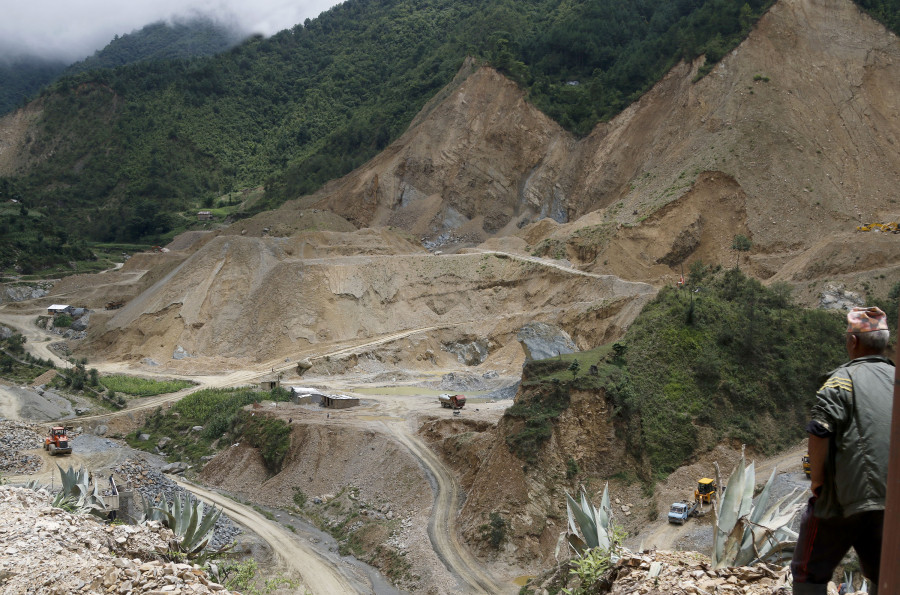Columns
The Chure conundrum
The consequences of mining aggregates are more severe than deforestation.
Madhukar Upadhya
The recent decision of the government to export sand and stones is both a disappointment and an exciting opportunity. It's disappointing because, despite decades of efforts to ban all kinds of unhealthy mining of sand and stone, the government plans to disregard all warnings and move forward with the exports. On the other hand, it's exciting because the decision has finally ignited a long-overdue debate among civilians to save Nepal’s precious non-renewable resources—sand and stones. In the past few decades, the domestic demand for these products has escalated drastically and so have the social and environmental impacts. Already, conflicts are rising between local communities and sand and stone miners.
While the government maintains that it has no intention of mining Chure, a fragile mountain region, for the purpose of exports, it's hard to believe that the region will be spared by miners even when designated quarries will be in the mountains north of Chure. Sand and gravel extraction has already led to massive environmental degradation across the Chure area and therefore, for valid reasons, the decision to export stones ignited such strong resentment.
Neighbouring systems
Chure, formed of young and unconsolidated rocks at the south end of the Himalayas, represents the southernmost frontier of the mountain range. The lower corridor of Chure, called Bhabar, is a small strip of land, about 3-5 kilometres wide and formed mostly by boulders, representing the northernmost boundary of the Ganga plain including Nepal Tarai. To understand the uniqueness of Chure and Bhabar, we need to recall the process that led to the formation of these two different neighbouring systems.
The Himalayan range was formed as a result of the collision between two tectonic plates—the Indian plate and the Eurasian plate—a process that is still ongoing. The Indian plate is moving northward and is sliding underneath the Eurasian plate, constantly building pressure as it lifts the mountains; this pressure often gets released causing earthquakes. The same pressure is also exerted on the Chure but its impact is felt differently since the region is mostly formed of unconsolidated rocks, which give way from the edge when such pressure is built. This trait not only makes Chure inherently unstable but also a place that generates debris even during the dry season.
Hydrologically, Chure has been and continues to be intensely dissected by innumerable streams and gullies. Most of them flow transversely to the grain of the hills. Though rainwater infiltrates rapidly, high-intensity rain usually generates high runoff. Within a short period, the runoff brings lots of debris along and deposits them on the Bhabar flank. To make the situation worse, what little ground cover grows in the southern slopes is often destroyed by occasional fires during the summer months.
Trouble begins
Nature has always had its own plans. The warm climate of Bhabar supported dense forests of hardwood trees that acted in two ways: it anchored the unstable boulders of Bhabar together and acted as a barrier for the debris coming from Chure which kept the fertile plains in the south safe from being buried underneath moving sand and gravel. Unfortunately, circumstances changed dramatically after the eradication of malaria in the 1960s and the distribution of land to migrants, who were mostly displaced by floods and landslides in the hills. At first, pastoralists moved in. But, in the following years, farming started taking deeper roots.
When the area was deforested by the settlers, it had a twofold effect: the boulders in Bhabar that were anchored by the network of roots got loosened and the barrier that blocked the debris from Chure was lost giving the debris-free passage. The debris movement became surprisingly rapid in some places. In one section, it's said that the debris moved 3 kilometres to the south in just 10 years—a previously unprecedented distance.
The impacts of the mistakes of the past continue to haunt us even today. By removing the forest cover for settlements more than half a century ago, we altered the dynamics of the region without thinking of the consequences. There is very little we can do to stop it now. Given the unique vulnerability of the border between the two systems of mountains and the plain, we don't have the luxury of making more mistakes, since we can't conceptualise the inevitable long-term environmental and economic fallout.
Since the extraction of non-renewable resources such as sand and stones has impacts that will last much longer than any short-term economic gain it provides, the consequences of mining aggregates are more severe than deforestation. Aggradation of river beds has begun to inundate areas that were safe in the past. Debris deposits and inundation increasingly threaten roads, bridges, and canals every year.
The declining water table is affecting small farmers as they are losing access to groundwater forcing many to invest in heavy pumps. The fallout of the depletion of groundwater and the increased siltation is connected with the increasing disconnect between people and farms. Unprofitable and unreliable rain-fed farming has pushed many farmers to look for alternate sources of income. Subsequently, many rice mills have closed down.
Interwoven issues
The mistreatment of our limited land resources is perfectly summarised by the fact that the continued degradation of land in the hills and mountains, which we ignored in the past and continue to ignore now, led to the conversion of Bhabar into farms and villages in the name of resettlement, leading to further degradation of land in the plains in just under a century. Currently, anywhere between 30-60 percent of land in the hills has been turned into bushland after it was abandoned by farmers. Shouldn’t that deeply worry us?
It's troubling that in order to fix certain problems, we are eager to invite a whole host of new problems. This lack of foresight to look at the interconnection between resources has plagued our policymaking for decades and the tendency continues to thrive even today. It’s no longer affecting marginalised communities alone but the overall national economy as we are forced to pump billions of rupees into reconstruction and rehabilitation projects.
Our economic woes are very real and need informed solutions immediately, especially as we buckle under the weight of the pandemic. But our environment is already struggling to cope with our past sins and the stresses of the looming climate crisis. Now is the time for innovative, novel policies—not regurgitated old hacks that have proven detrimental. Mining fragile mountains for sand, gravel, and stone will only lead to unimaginable peril. Surely, no profit is worth that.




 18.12°C Kathmandu
18.12°C Kathmandu















